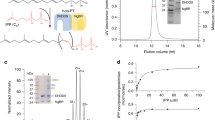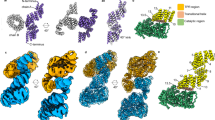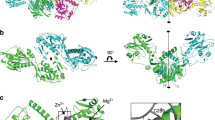Abstract
ALDOSE reductase is the first enzyme in the polyol pathway and catalyses the NADPH-dependent reduction of D-glucose to D-sorbitol. Under normal physiological conditions aldose reductase participates in osmoregulation1, but under hyperglycaemic conditions it contributes to the onset and development of severe complications in diabetes2. Here we present the crystal structure of pig lens aldose reductase refined to an R-factor of 0.232 at 2.5-Å resolution. It exhibits a single domain folded in an eight-stranded parallel α/β barrel, similar to that in triose phosphate isomerase3 and a score of other enzymes. Hence, aldose reductase does not possess the expected canonical dinucleotide-binding domain4. Crystallographic analysis of the binding of 2′-monophospho-adenosine-5′-diphosphoribose, which competitively inhibits NADPH binding reveals that it binds into a cleft located at the C-terminal end of the strands of the α/β barrel. This represents a new type of binding for nicotinamide adenine dinucleotide coenzymes.
This is a preview of subscription content, access via your institution
Access options
Subscribe to this journal
Receive 51 print issues and online access
$199.00 per year
only $3.90 per issue
Buy this article
- Purchase on Springer Link
- Instant access to full article PDF
Prices may be subject to local taxes which are calculated during checkout
Similar content being viewed by others
References
Burg, M. B. Kidney Int. 33, 635–641 (1988).
Dvornik, D. in Aldose Reductase Inhibition. An Approach to the Prevention of Diabetic Complications (McGraw-Hill, New York, 1987).
Banner, D. W. et al. Nature 255, 609–614 (1975).
Rossmann, M. G., Moras, D. & Olsen, K. W. Nature 250, 194–199 (1974).
Wermuth, B. Prog. Clin. biol. Res. 174, 209–230 (1985).
Bohren, K. M., Bullock, B., Wermuth, B. & Gabbay, K. H. J. biol. Chem 264, 9547–9551 (1989).
Chung, S. & LaMendola, J. J. biol. Chem. 264, 14775–14777 (1989).
Nishimura, C., Wistow, G. & Carper, D. Prog. clin. biol. Res. 290, 211–220 (1989).
Schade, S. Z. et al. J. biol. Chem. 265, 3628–3635 (1990).
Watanabe, K. et al. Proc. natn. Acad. Sci. U.S.A. 85, 11–15 (1988).
Anderson, S. et al. Science 230, 144–149 (1985).
Fujii, Y. et al. J. biol. Chem. 265, 9914–9923 (1990).
Winters, C. J., Molowa, D. T. & Guzelian, P. S. Biochemistry 29, 1080–1087 (1990).
Oechsner, U., Magdolen, V. & Bandlow, W. FEBS Lett. 238, 123–128 (1988).
Wierenga, R. K., Drenth, J. & Schulz, G. E. J. molec. Biol. 167, 725–739 (1983).
Bystroff, C., Oatley, S. J. & Kraut, J. Biochemistry 29, 3263–3277 (1990).
Wierenga, R. K., De Maeyer, M. C. H. & Hol, W. G. J. Biochemistry 24, 1346–1357 (1985).
Farber, G. K. & Petsko, G. A. Trends biol. Sci. 15, 228–234 (1990).
Lindqvist, Y., Brändén, C.-l., Mathews, F. S. & Lederer, F. J. biol. Chem. 266, 3198–3207 (1991).
Rondeau, J. M. et al. J. molec. Biol. 195, 945–948 (1987).
Kabsch, W. J. appl. Crystallogr. 21, 916–924 (1988).
Terwilliger, T. C. & Kim, S.-H. Acta crystallogr. A43, 1–5 (1987).
Terwilliger, T. C. & Eisenberg, D. Acta crystallogr. A39, 813–817 (1983).
Jones, T. A. in Computational Crystallography 303–317 (Clarendon, Oxford, 1982).
Brünger, A. T., Kuriyan, J. & Karplus, M. Science 35, 458–460 (1987).
Priestle, J. J. appl. Crystallogr. 21, 572–576 (1988).
Grimshaw, C. E. et al. Biochemistry 28, 5343–5353 (1989).
Vander Jagt, D. L., Robinson, B., Taylor, K. K. & Hunsaker, L. A. J. biol. Chem. 265, 20982–20987 (1990).
Del Corso, A. et al. Arch. biochem. biophys. 270, 604–610 (1989).
Del Corso, A. et al. Arch. biochem. biophys. 283, 512–518 (1990).
Author information
Authors and Affiliations
Rights and permissions
About this article
Cite this article
Rondeau, JM., Tête-Favier, F., Podjarny, A. et al. Novel NADPH-binding domain revealed by the crystal structure of aldose reductase. Nature 355, 469–472 (1992). https://doi.org/10.1038/355469a0
Issue Date:
DOI: https://doi.org/10.1038/355469a0
This article is cited by
-
Dietary flavonoids inhibit the glycation of lens proteins: implications in the management of diabetic cataract
3 Biotech (2019)
-
Antidiabetic and allied biochemical roles of new chromeno-pyrano pyrimidine compounds: synthesis, in vitro and in silico analysis
Medicinal Chemistry Research (2017)
-
Novel insights into the structural requirements for the design of selective and specific aldose reductase inhibitors
Journal of Molecular Modeling (2012)
-
Molecular cloning and biochemical characterization of a novel erythrose reductase from Candida magnoliae JH110
Microbial Cell Factories (2010)
-
In reply—Some are not in the family
Nature Structural & Molecular Biology (1996)
Comments
By submitting a comment you agree to abide by our Terms and Community Guidelines. If you find something abusive or that does not comply with our terms or guidelines please flag it as inappropriate.



